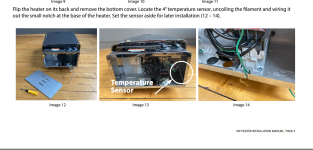TheGingerElectrician
Master Electrician Electrical Contractor, TN
- Location
- Tennessee
- Occupation
- Electrical Contractor
We recently installed a sauna heater unit a customer purchased and installed the circuit correctly but when turning the unit on it shorted inside the unit. After investigation and further contact with the manufacturer, they informed us we missed a step in the installation instructions. The instructions said to remove the temperature probe which they install at the manufacturer because it can cause a short against the unit when first kicked on in certain circumstances. They will not warranty the unit because we missed this step.
In order to make things right with the customer, we have already ordered and paid for a brand-new unit. I was tempted to cancel the card after we get the unit but I know it wouldn't be ethical. Should I calm down or am I right in being upset with the manufacturer? This will of course induce a meeting with everyone stating the importance of reading the instructions.
1. I know they have us on a technicality because it is in their instructions and we should have read the instructions and caught it.
2. From my perspective this is bad practice from the manufacturer because they are sending a unit with items they installed in the unit that can cause a short even if you do everything correctly. It really feels from my perspective that they are just trying to save money in their process and pass the liability of a bad practice onto the installer.
3. Any suggestions on how to handle this with technicians who are made aware of this and don't follow the right course in reading through the instructions?
Any ideas or helpful thoughts/conversation or advise on this?
In order to make things right with the customer, we have already ordered and paid for a brand-new unit. I was tempted to cancel the card after we get the unit but I know it wouldn't be ethical. Should I calm down or am I right in being upset with the manufacturer? This will of course induce a meeting with everyone stating the importance of reading the instructions.
1. I know they have us on a technicality because it is in their instructions and we should have read the instructions and caught it.
2. From my perspective this is bad practice from the manufacturer because they are sending a unit with items they installed in the unit that can cause a short even if you do everything correctly. It really feels from my perspective that they are just trying to save money in their process and pass the liability of a bad practice onto the installer.
3. Any suggestions on how to handle this with technicians who are made aware of this and don't follow the right course in reading through the instructions?
Any ideas or helpful thoughts/conversation or advise on this?


